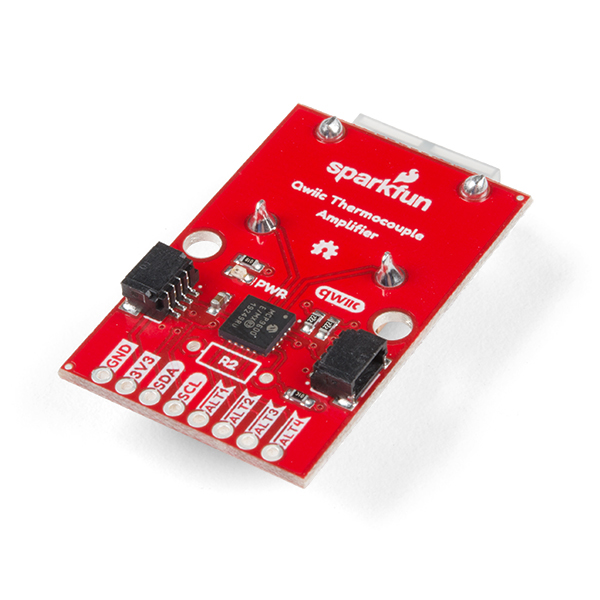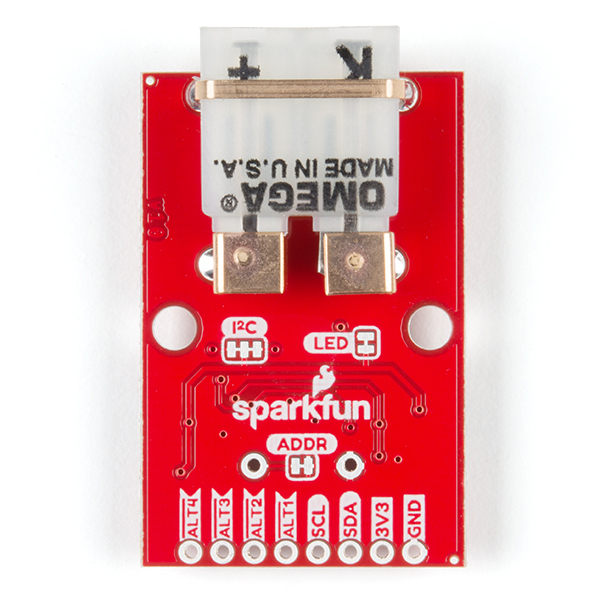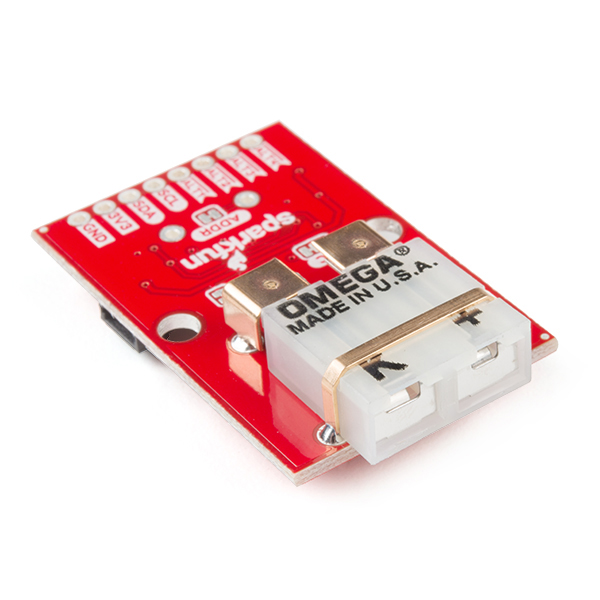SparkFun Qwiic Thermocouple Amplifier - MCP9600 (PCC Connector)
The MCP9600 Breakout is a high accuracy Thermocouple Amplifier equipped with an I2C interface, accessed over our Qwiic system. Inside the chip are two temperature sensors, one for the thermocouple itself (the hot junction) and one for the chip itself (the cold junction). As a result, the MCP9600 can read both the ambient temperature and the temperature of whatever you're trying to measure! The MCP9600 can do both with a resolution of 0.0625°C, and an accuracy of ±1.5°C (worst-case). The MCP9600 Thermocouple Amplifier is one of our many Qwiic compatible boards! Simply plug and go. No soldering, no figuring out which is SDA or SCL, and no voltage regulation or translation required!
This version of the board comes equipped with a PCC connector to accept a K-type thermocouple. This makes it perfect for a variety of applications, from measuring the temperature of your Crock-Pot to making sure your backyard induction furnace is up to temperature.
In addition, the MCP9600 has four on-board temperature alerts that you can configure! Instead of constantly polling the sensor over I2C, you can set a temperature limit to trigger an interrupt when the temperature reaches a certain value. This frees up your microcontroller and your I2C bus to do more important things. It's also possible to put the MCP9600 into alternate operation modes in order to save power. The sensor supports a burst mode, where it will take a specified number of samples, return the results, and then go to sleep. This low-power mode makes the MCP9600 perfect for portable applications!
We've written an Arduino library to help you get started quickly. You can download the library through the Arduino library manager by searching 'SparkFun MCP9600' or you can get the GitHub repo as a .zip file and install the library from there.
The SparkFun Qwiic Connect System is an ecosystem of I2C sensors, actuators, shields and cables that make prototyping faster and less prone to error. All Qwiic-enabled boards use a common 1mm pitch, 4-pin JST connector. This reduces the amount of required PCB space, and polarized connections mean you can’t hook it up wrong.
The MCP9600 Qwiic Thermocouple Amplifier can also be automatically detected, scanned, configured, and logged using the OpenLog Artemis datalogger system. No programming, soldering, or setup required!
- Temperature Range of -200°C to 1350°C
- Four Onboard Temperature Alerts
- Resolution of 0.0625°C
- PCC Connector for K-Type Thermocouple
- ADDR Jumper for variable I2C Addresses (default address of 0x60)
- 2x Qwiic Connectors
SparkFun Qwiic Thermocouple Amplifier - MCP9600 (PCC Connector) Product Help and Resources
SparkFun Qwiic Thermocouple Hookup Guide
March 12, 2020
Learn how to hook up your Qwiic Thermocouple Amplifier.
Core Skill: Programming
If a board needs code or communicates somehow, you're going to need to know how to program or interface with it. The programming skill is all about communication and code.
Skill Level: Rookie - You will need a better fundamental understand of what code is, and how it works. You will be using beginner-level software and development tools like Arduino. You will be dealing directly with code, but numerous examples and libraries are available. Sensors or shields will communicate with serial or TTL.
See all skill levels
Core Skill: Electrical Prototyping
If it requires power, you need to know how much, what all the pins do, and how to hook it up. You may need to reference datasheets, schematics, and know the ins and outs of electronics.
Skill Level: Rookie - You may be required to know a bit more about the component, such as orientation, or how to hook it up, in addition to power requirements. You will need to understand polarized components.
See all skill levels
Comments
Looking for answers to technical questions?
We welcome your comments and suggestions below. However, if you are looking for solutions to technical questions please see our Technical Assistance page.
Customer Reviews
4 out of 5
Based on 1 ratings:
Good, accurate thermocouple amplifier
Better than the MAX31855 as it has a much higher resolution ADC (doesn't matter for type K probes as much but does for other types), and the Qwiic connector is definitely a plus. And a proper connector rather than screw terminals!
But, I have to knock off some stars because it can't do the ONE thing I expected: detect when the probe is unplugged.
While the MAX31855 has a bit field for detecting when the TC is unplugged, the MCP9600 recommends doing this by adding some resistors and checking for out-of-range. Sadly, the first revision of this device lacks these resistors. When you disconnect the probe, you get a floating reading which jumps around wildly.
EDIT: Reading more into the device, it looks like the MCP9600 isn't designed to detect this as well as the MCP9601. However even that chip has some issues causing it to fail to detect open circuit. So adding back a star because this isn't really SparkFun's fault but Microchip's for having issues in the silicon for years before releasing errata about it.






Hi, does the MCP9600 support multi-address configuration on the I2C bus, or does the Qwiic system have a way of supporting multiple I2C devices with the same address? My goal would be to have multiple TCs in a system. Thanks
♫The answer my friend, is blowing in the hookup guide, ♪ the answer is in the hookup, guide. ♬
Bob Dylan just felt a disturbance in the force. Has no idea why.
Is it possible to get this without the PCC soldered or maybe you guys change the PCC to Type B? Using a type K PCC means the user is restricted to type K TCs (due to the chemical makeup of the connector), whereas if you used a type B (copper-copper) the user could use any type TC (since the cold junction compensation happens so close to the connector. This would open up more of a market.
Although we don't offer a version of the board with a PCC to Type B variation, we do offer a version of this board without Qwiic and without the PCC Connector pre-soldered. We also released a version of this board with a screw terminal today in order for more user-defined options.
We decided to release this PCC Connector type and the version with a screw terminal to provide individuals with a common connector (PCC) as well as one that provides more options (screw terminal). Hopefully, this helps!
Thanks for the reply! To be clear, the point I was making was switching to the B type or U type PCC would change nothing about what you have supported here while simultaneously adding support for all the other TC types (since the cold junction is so close by), which seems like a win-win. The screw terminal unit is helpful, thanks. The other unit is a lower resolution, so not particularly good for type R/S or B TCs.